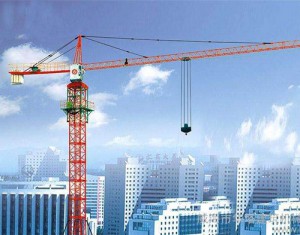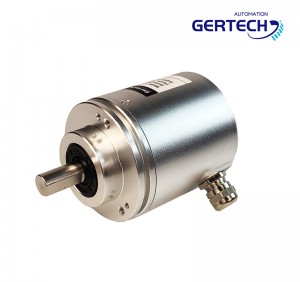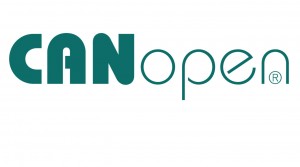Encoder Applications/Hoisting Machinery
Encoder for Hoisting Machinery
Application case of synchronous correction control of large-span door crane lifting equipment based on Canopen fieldbus.
one. The particularity of door crane lifting equipment:
The safety requirements of door crane lifting equipment are becoming more and more prominent, and the concept of safety first is becoming more and more important in control. According to regulations, large-span door cranes above 40 meters must be equipped with dual-track synchronous correction control to prevent left and right double-tracks. The accident of the door machine wheel is too off and gnaws the track or even derails. Due to safety requirements, the left and right double track wheels of the door machine need to be controlled at multiple points. The reliable feedback of speed, position and other information directly relates to the safety and reliability of the control. The particularity of the environment of the crane's lifting equipment determines the particularity of the selection of these signal sensors and transmissions:
1. In the complex working environment on site, frequency converters, large motors and high and low voltage power supply systems, signal cables are often arranged together with power lines, and the electrical interference on site is very serious.
2. Equipment mobility, long moving distance, difficult to ground.
3. The signal transmission distance is long, and the safety and reliability of the signal data is high.
4. Synchronous control requires high real-time and reliable signal transmission.
5. Many of them are used outdoors, with high requirements for protection level and temperature level, but low level of worker training, and high requirements for product tolerance.
two. The significance of the absolute value multi-turn encoder in the application of door crane lifting equipment:
There are potentiometers, proximity switches, incremental encoders, single-turn absolute encoders, multi-turn absolute encoders, etc. in the use of position sensors for door cranes. In comparison, the reliability of potentiometers is low , Poor accuracy, dead zone in use angle; Proximity switches, ultrasonic switches, etc. are only single-point position signals but not continuous; Incremental encoder signal anti-interference is poor, the signal cannot be transmitted remotely, and the power failure position is lost; Single-turn absolute encoder It can only work within 360 degrees. If the measurement angle is expanded by changing the speed, the accuracy will be poor. If it is used directly in a single circle to achieve multi-lap control through memory, after a power failure, it will lose its position due to wind, sliding or artificial movement. Only the absolute value multi-turn encoder can be used safely in the hoisting equipment of the door machine. It is not affected by the power outage jitter. It can work with long distances and multi-turns. The internal full digitalization, anti-interference, and signal can also be realized. Long-distance safe transmission. Therefore, from the perspective of the safety of door hoisting equipment, the absolute value multi-turn encoder is an inevitable choice.
Application recommendation of Canopen absolute encoder in door crane lifting equipment
CAN-bus (ControllerAreaNetwork) is the controller area network, which is one of the most widely used open field buses in the world. As a remote network communication control method with advanced technology, high reliability, complete functions and reasonable cost, CAN-bus has been widely used in various automation control systems. For example, CAN-bus has incomparable advantages in various fields such as automotive electronics, automatic machinery, intelligent buildings, power systems, security monitoring, ships and shipping, elevator control, fire safety, medical equipment, etc., especially when it is currently in the limelight. Can-Bus is the preferred signal standard for high-speed railways and wind power generation.CAN-bus is developed and maintained with low cost, high bus utilization, long transmission distance (up to 10Km), high-speed transmission rate (up to 1Mbps), multi-master structure according to priority, and reliable The error detection and processing mechanism fully compensates for the traditional RS-485 network's low bus utilization, single-master-slave structure, and no hardware error detection deficiencies, enabling users to build a stable and efficient field bus control system, resulting in maximum actual value. In harsher application environments such as lifting equipment, Can-bus has a reliable signal error detection and processing mechanism, and can still transmit data well in the case of strong interference and unreliable grounding, and its hardware error self-check, The multi-master station can be redundant to ensure the safety of the control equipment.
Canopen is an open protocol based on the CAN-bus bus and managed by the CiA Association. It is mainly used in the vehicle industry, industrial machinery, intelligent buildings, medical equipment, marine machinery, laboratory equipment and research fields. The Canopen specification allows messages to be transmitted by broadcasting. , It also supports point-to-point sending and receiving of data, and users can perform network management, data transmission and other operations through the Canopen object dictionary. In particular, Canopen has the characteristics of anti-interference and multi-master station application, which can form the actual master station redundancy backup and realize safer control.
Compared with other signal forms, Canopen's data transmission is more reliable, economical, and safer (equipment error reporting). Comparison of these characteristics with other outputs: Parallel output signal-too many power components are easily damaged, too many core wires are easily broken and the cable cost is high; SSI output signal-called synchronous serial signal, when the distance is long or interfered, the signal The delay caused the clock and data signal to no longer be synchronized, and data jump occurred; Profibus-DP bus signal-grounding and cable requirements are high, the cost is too high, the master station is not selectable, and once the bus connection gateway or master station fails, Cause the paralysis of the entire system and so on. The above use in lifting equipment may sometimes be fatal. Therefore, it can be said that the Canopen signal is more reliable, more economical and safer when used in lifting equipment.
Gertech Canopen absolute encoder, due to its high-speed signal output, in the function setting, you can set the encoder's absolute angle position value and the variable speed value to output together, for example, the first two bytes output absolute Value angle (multiple turns) position, the third byte outputs the speed value, and the fourth byte outputs the acceleration value (optional). This is very helpful when the lifting equipment uses frequency converters. The speed value can be As the feedback of frequency conversion speed regulation, and the position value can be used as precise positioning and synchronization control, and it can have double closed-loop control of speed and position, so as to realize precise positioning, synchronization control, parking anti-sway, safe area control, collision prevention, speed safety protection, etc. , And Canopen’s unique multi-master feature can realize the redundancy backup of the master station of the receiving controller. The backup controller parameters can be set behind the master controller. Once the master controller system fails, the backup controller can assume the final The safety protection and control of the lifting equipment can be realized.
The large motor of the door crane lifting equipment is started and used outdoors. The encoder signal cable is long, which is equivalent to a long antenna. The surge and overvoltage protection of the field signal end is very important. In the past, parallel signal encoders or incremental encoders were used. , There are many signal core cables, and the surge overvoltage protection of each channel is difficult to achieve (the surge voltage generated by the start of a large motor or a lightning strike), and often the encoder signal has a port burnout; and the SSI signal is a synchronous series connection, such as adding a wave Surge protection, signal transmission delay destroys the synchronization and the signal is unstable. The Canopen signal is high-speed asynchronous or broadcast transmission, which does not have much influence on the insertion of the surge protector. Therefore, if the Canopen encoder and the receiving controller are added to the surge overvoltage protector, it can be used more safely.
Canopen controller PFC
Due to the advanced nature and safety of Canopen signals, many PLC manufacturers and controller manufacturers have added Canopen interfaces to achieve Canopen control, such as Schneider, GE, Beckhoff, B&R, etc. Gemple’s PFC controller is A small controller based on the Canopen interface, which includes an internal 32-bit CPU unit, a liquid crystal display and a man-machine interface for setting buttons, 24-point switch I/O and multiple analog I/O, and a 2G SD memory card , Can record power-on and shutdown, program event records, so as to realize the black box recording function, failure analysis and prevention of illegal operations by workers.
Since 2008, PLC manufacturers of major famous brands have recently added Canopen interface or are planning to add Canopen interface. Whether you choose PLC with Canopen interface or PFC controller with Gertech, the control based on Canopen interface will be lifted. The application of equipment has gradually become the mainstream.
five. Typical application case
1. Synchronous deviation correction for the carriage of door cranes—Two Canopen absolute value multi-turn encoders detect the synchronization of the left and right wheels, and the signal is output to the Canopen interface controller for PFC synchronization comparison. At the same time, the Canopen absolute value encoder can output speed feedback at the same time , Through the controller to provide inverter speed control, realize small deviation correction, large deviation correction, over-deflection parking and other controls.
2. Speed safety protection—Canopen absolute encoder outputs position value and speed value at the same time (direct output without external calculation), and has a faster response to speed protection.
3. Safety redundancy control—Using Canopen's multi-master redundancy feature, the PFC201 controller can be dual-redundant backup, and the second controller can be added according to user needs for safe backup.
4. Safety record function, the PFC201 controller has a 2G SD memory card, which can record events (black box) to realize failure analysis and prevent illegal operations by workers (safety record check), and achieve safer control.
5. Parking positioning and anti-swaying—Using the position and speed output characteristics of Canopen absolute encoder at the same time, it can realize the dual closed-loop control of parking positioning and slow deceleration, which can reasonably stop the speed and position curve, and reduce the swing of the lifting point when parking.
6. Typical application introduction:
Guangdong Zhongshan Sea-Crossing Bridge construction site large-span gantry crane hoisting equipment synchronous correction control, about 60 meters span, gantry crane height of more than 50 meters, two encoder signals to the PFC controller cable total length of 180 meters. Optional:
1. Canopen absolute multi-turn encoder—Gertech absolute multi-turn encoder, GMA-C Series CANopen Absolute Encoder, protection grade shell IP67, shaft IP65; temperature grade -25 degrees-80 degrees.
2. Canopen Controller—Gertch's Canopen-based controller: It can be used not only as the main controller, but also as a redundant backup controller.
3. Canopen signal port surge protector: SI-024TR1CO (recommended)
4. Encoder signal cable: F600K0206







